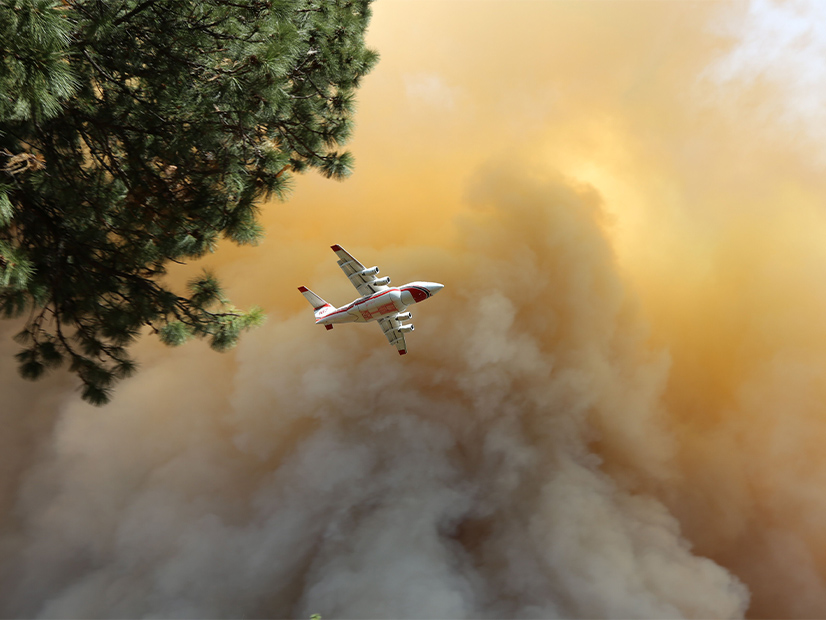
Pacific Gas and Electric said Thursday it would incur $100 million in costs from this year’s Mosquito Fire, two days after regulators proposed fining the company $155 million for 2020’s deadly Zogg Fire.
The potential losses from the Mosquito Fire were reported in PG&E’s third-quarter earnings report to the Securities and Exchange Commission and discussed in an earnings call Thursday.
The Mosquito Fire began Sept. 6 in the Sierra Nevada foothills about 50 miles northeast of Sacramento. It burned through nearly 77,000 acres, mainly in the El Dorado and Tahoe national forests, and destroyed 78 structures.
The U.S. Forest Service launched a criminal investigation of PG&E for its role in starting the fire and seized utility equipment near the ignition point, including a PG&E transmission pole. PG&E previously told the California Public Utilities Commission (CPUC) that it had recorded “electrical activity” on the suspect line when the fire started.
PG&E CEO Patti Poppe said Thursday the wildfire costs would be covered by insurance.
“We added the Mosquito Fire to our CPUC reportable ignitions greater than or equal to 100 acres,” Poppe said. “Though the investigation is not complete, we can see that the fire started near the base of our 60-kV steel pole … [and] we booked a liability for the Mosquito Fire of $100 million, which is well within our range of insurance.”
On Tuesday, the CPUC proposed fining PG&E $155.4 million for the Zogg Fire, which killed four people including a mother and her young daughter who were overtaken by flames while fleeing the blaze.
The fire started Sept. 27, 2020, when a gray pine tree fell onto a PG&E distribution line in rural Shasta County, the California Department of Forestry and Fire Protection found. It burned 56,000 acres and destroyed more than 200 structures.
A contractor working for PG&E had failed to remove the pine tree even though it was leaning dangerously toward the power line and had shallow roots, a federal judge overseeing PG&E’s criminal probation said in a February 2021 hearing. The line that the tree struck had remained energized even though PG&E had ordered widespread public safety power shutoffs in the surrounding area because of high winds, the judge learned.
“I think it was reckless, maybe criminally reckless, for PG&E to have left that tree, that gray pine looming,” Judge William Alsup said in the hearing. “It was leaning at a 60-degree angle over that line. Gray pines … have a shallow root system. That tree had also been burned earlier. That tree was a clear and present danger to the line, and whoever made the decision to leave that tree up should be looked at very carefully. And PG&E did leave it up.”
The CPUC said in its proposed order Tuesday that the utility had failed “to remove two trees [including the gray pine] previously flagged for removal due to a combination of poor recordkeeping, poor communication, and lack of caution. Juxtaposing PG&E’s failure to remove the trees with [an arborist’s report] — showing that the tree was clearly likely to fall — demonstrates a high degree of culpability in PG&E’s conduct.”
After the CPUC finalizes its order, PG&E will have 30 days to request a hearing or to agree to pay the penalty and submit a corrective action plan. The plan must show that PG&E has a system in place to keep track of trees slated for removal.
The actions against PG&E for the Zogg and Mosquito fires are the latest in a series of financial penalties, criminal convictions and payments to wildfire victims related to catastrophic fires started by PG&E equipment in the past five years.
The wildfires included the Northern California wine country fires of October 2017; the Camp Fire, which killed at least 84 people and leveled the town of Paradise, in November 2018; the Kincade Fire, which tore through Sonoma County in October 2019; and the nearly 1-million-acre Dixie Fire, the state’s second largest wildland blaze, which raged for months in 2021.
The company filed for bankruptcy protection in January 2019 following the Camp Fire and emerged from Chapter 11 proceedings in June 2019, after agreeing to pay a total of $25.5 billion to fire victims, insurance companies and local governments for the wine country fires and the Camp Fire.
PG&E reported third-quarter earnings of $456 million (21 cents/share), compared with losses of $1.09 billion (.055 cents/share) in Q3 2021. Its stock closed at $15.60 on Thursday.


